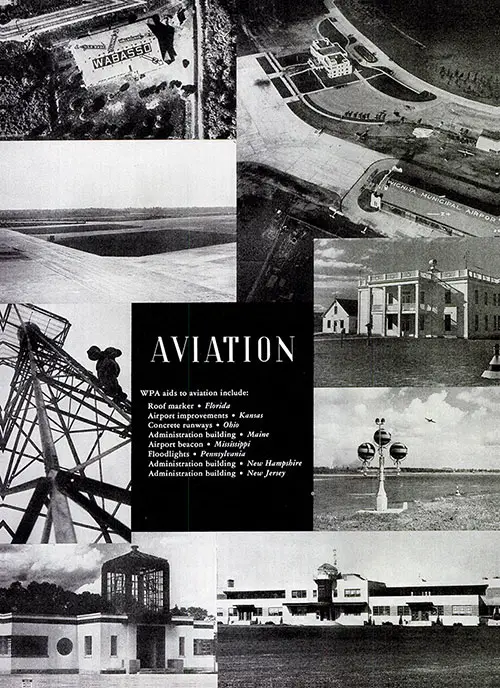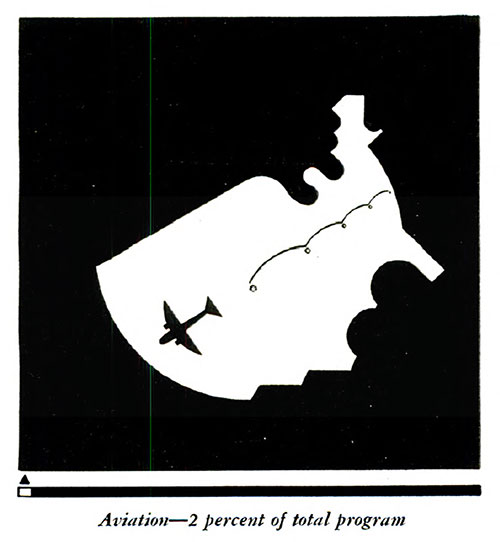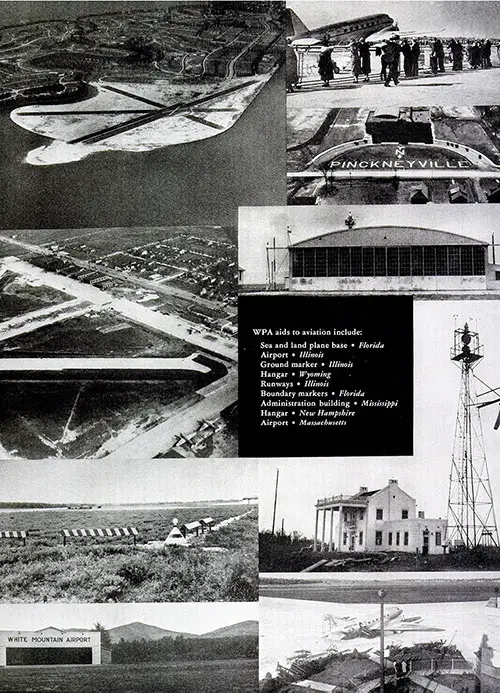🛩️ How the WPA Built America’s Airports & Advanced Aviation (1938)
📌 This 1938 WPA report details the construction of airports, runways, airfields, and navigational aids that fueled the growth of American aviation. A must-read for historians, teachers, and aviation enthusiasts studying New Deal infrastructure and transportation history.

Collage of WPA Aids to Aviation Include: Roof Marker (Florida), Airport Improvements (Kansas), Concrete Runways (Ohio), Administration Building (Maine), Airport Beacon (Mississippi), Floodlights (Pennsylvania), Administration Building (New Hampshire), Administration Building (New Jersey). Inventory: An Appraisal of Results of the Works Progress Administration, Washington, DC: US Government Printing Office, 1938. | GGA Image ID # 151f3af27e
✈️ WPA Aviation Projects - 1938
The WPA's Critical Role in Expanding American Aviation Infrastructure
📖 The 1938 WPA report on aviation projects highlights the massive impact of the Works Progress Administration in modernizing America’s air travel infrastructure. The report details how WPA labor helped construct and improve landing fields, runways, hangars, airport terminals, and lighting systems, directly contributing to the growth of commercial aviation and national defense.
For historians, teachers, genealogists, and aviation enthusiasts, this document serves as a vital record of:
🔹 The rapid expansion of aviation infrastructure during the Great Depression.
🔹 How WPA projects supported both civilian air travel and military preparedness.
🔹 The role of federal funding in modernizing local and national airports.
🛠️ This report provides an in-depth look at how government-sponsored public works shaped the future of air travel in America.
The WPA's completed work on 266 landing fields has aided American municipalities in their desperate struggle to keep ground facilities abreast of the phenomenal growth in the size and speed of transport airplanes.

Subject Matter Index Page to WPA Projects in Aviation—2 Percent of Total Program. Inventory: An Appraisal of Results of the Works Progress Administration, Washington, DC: US Government Printing Office, 1938. | GGA Image ID # 151f7eb8f3
WPA workers have constructed 130 new landing fields and improved 136 others, embracing a total area of nearly 34,000 acres. They have constructed new runways totaling more than 200 miles in length and repaired or improved an additional 72 miles. These runways range from 50 to 350 feet in width.
They have built 73 new hangars and completed improvements on 75 others, as shown under the section on Public Buildings, as well as constructed several score administration buildings and other lesser airport structures. The new and improved hangars are capable of housing more than 1,900 aircraft.
They have installed lighting facilities on 276 airports, athletic fields, or other outdoor areas requiring high illumination, and erected 36 air beacons of both the visual and radio beam type. To assist aviators in getting their bearings while in flight, WPA workers have painted or constructed 8,357 air markers—large signs on the roofs of buildings or on the ground which can be read from the air, giving the location of the marker and of the nearest airport.
Federally paid WPA manpower from the relief rolls was made available to local communities at a time when American municipalities in many cases had found themselves unable to continue their airport development because of reduced tax revenue. Hundreds of them were able, however, to provide local funds for materials and equipment, and these applied for airport projects.
Locations and general plans were passed upon for technical flaws by the Bureau of Air Commerce, while counsel on the general program was given by the War and Navy Departments concerning national defense, as well as by the Post Office Department concerning air mail routes.
WPA airport improvements range from major facilities for several score of the Nation's largest terminals to simple clearing and leveling of emergency landing fields in hazardous flying areas.
Examples of its major improvements include construction of the bituminous landing mat at Cleveland airport, the largest single piece of paving in the world; construction of the administration building and huge public hangar at Newark, the Nation's busiest terminal; and extensive improvement to Boiling Field, important Army post in Washington, D. C.
There is scarcely an airport on the country's entire airline system which has not been improved in some respect by the WPA. In Chicago and San Francisco, in Salt Lake City, Fort Worth, and Boston, in St. Louis and Detroit, in Kansas City and New Orleans, Charleston and Akron, Pittsburgh and Washington—on literally hundreds of American airports, these workers who couldn't find private jobs have built a wide variety of needed facilities.
Under the sponsorship of the city of New York, they are building the great new terminal at North Beach, on Flushing Bay, adjacent to the World's Fair grounds. Such projects provide a high proportion of labor for unskilled manual workers in large- scale grading and drainage operations, while skilled workers such as engineers and draftsmen also are needed.
Of this airport and airway program, the late Major General O. Westover, Chief of the Army Air Corps, said on July 7, 1937: "You are apparently making excellent progress, and everywhere I go I have heard the most favor- able comment upon the progressive work being accomplished."
W. H. Gannett, Maine publisher and flying enthusiast, said, "I don't know of any development work undertaken by the Federal administration that is more important or of greater lasting benefit to the general public."
Harry W. Colmery, National Commander of the American Legion in July 1937, called the program "a basic contribution to the national defense."
Gill Robb Wilson, President of the National Association of State Aviation Officials, following a Nation-wide tour of these projects, said in his annual report on December 2, 1937: "From either the standpoint of original construction or improvement on already existing airports, the majority of those WPA projects which we visited and inspected represent a full decade of normal growth of aviation ground facilities. Both air commerce and national defense owe a debt of sincere gratitude to the Works Progress Administration."

Collage of WPA Projects and Aids to Aviation: Sea and Land Plane Base (Florida), Airport (Illinois), Ground Marker (Illinois), Hangar (Wyoming), Runways (Illinois), Boundary Markers (Florida), Administration Building (Mississippi), Hangar (New Hampshire), Airport (Massachusetts). Inventory: An Appraisal of Results of the Works Progress Administration, Washington, DC: US Government Printing Office, 1938. | GGA Image ID # 151f61e4fe
ADDENDA
While airport work of a somewhat heavier type has been carried out under the WPA than under the CWA and FERA, the earlier programs operated projects on more than 1,200 landing fields of all classes. The three programs, taken together, have built 750 new fields and made needed improvements on nearly 750 others.
"Aviation," in Inventory: An Appraisal of Results of the Works Progress Administration, Washington, DC: US Government Printing Office, 1938, pp. 29-32.
Why This Document is Important
📜 Relevance for Different Audiences
✔ For Historians & Researchers
🔹 Documents how the WPA shaped the modern U.S. airport system.
🔹 Provides insight into New Deal-era transportation policies.
🔹 Demonstrates the relationship between federal programs and technological progress.
✔ For Genealogists & Family Historians
🔹 Identifies potential ancestors who may have worked on WPA aviation projects.
🔹 Explores how air travel development affected specific communities.
🔹 Links family history to the infrastructure improvements of the Great Depression.
✔ For Teachers & Students
🔹 Illustrates how public works projects contributed to economic recovery.
🔹 Explores the connection between New Deal programs and aviation growth.
🔹 Provides case studies on federal investment in transportation.
📌 This report serves as a historical record of how government projects accelerated aviation development in the U.S.
::::: Most Engaging & Insightful Content :::::
🏗️ Building America’s Air Infrastructure: The WPA’s Impact
✔ Why This is Fascinating:
🔹 130 new landing fields were constructed, and 136 existing fields were improved.
🔹 More than 200 miles of new runways were built, accommodating larger and faster planes.
🔹 Over 276 airports were fitted with new lighting systems, improving safety for night flights.
✔ Key Takeaway:
The WPA helped communities modernize their airports at a time when tax revenues were too low to fund improvements.
📌 This section highlights how the WPA kept American aviation infrastructure on pace with rapid technological advancements.
🛬 Expanding Air Travel & Supporting National Defense
✔ Why This is Fascinating:
🔹 Runway and infrastructure improvements were made at major terminals, including Chicago, San Francisco, Salt Lake City, Detroit, and New Orleans.
🔹 The Newark Airport terminal and public hangar were built under WPA projects, supporting what was then the nation’s busiest air terminal.
🔹 Boiling Field (Washington, D.C.), a key military airbase, received extensive WPA improvements.
✔ Key Takeaway:
The WPA’s work was not just about economic recovery but also about strengthening military preparedness and commercial aviation.
📌 This section connects the WPA’s aviation projects to both national security and economic growth.
🌎 Air Markers & Beacons: Navigating the Skies
✔ Why This is Fascinating:
🔹 8,357 air markers were painted or built, acting as giant navigational signs for pilots.
🔹 36 air beacons were installed, aiding both visual and radio navigation.
🔹 Hundreds of lighting facilities were added to runways, making night flights safer.
✔ Key Takeaway:
These improvements paved the way for more reliable air travel, helping pilots navigate long before modern GPS systems existed.
📌 This section highlights how the WPA improved aviation safety and efficiency.
🏛️ Major Praise for WPA Aviation Projects
✔ Why This is Fascinating:
🔹 Military leaders, aviation experts, and business figures praised the WPA’s contributions.
🔹 Major General O. Westover, Chief of the Army Air Corps, called WPA progress “excellent.”
🔹 The American Legion described the program as “a basic contribution to national defense.”
🔹 Gill Robb Wilson of the National Association of State Aviation Officials estimated that the WPA’s work accounted for “a full decade of normal growth” in aviation infrastructure.
✔ Key Takeaway:
The WPA was widely recognized as a key force behind America’s aviation advancements.
📌 This section shows that the WPA was not just a work relief program but a major player in America’s aviation future.
🖼 Noteworthy Images & Their Significance
🖼 📍 "Collage of WPA Aids to Aviation"
Features airport terminals, hangars, airfield lighting, and runway projects, showcasing the WPA’s impact on airport infrastructure.
🖼 📊 "Aviation Projects – 2% of Total WPA Program"
Highlights the importance of aviation within the broader WPA construction efforts.
🖼 🛫 "Collage of WPA Projects and Aids to Aviation"
Displays the variety of aviation-related projects, from runway construction to navigation beacons.
📌 These images visually reinforce how the WPA helped expand aviation infrastructure nationwide.
Bias & Perspective Considerations
✔ Pro-WPA Tone:
The report strongly emphasizes the positive impact of WPA aviation projects but does not discuss potential challenges such as budget constraints, mismanagement, or criticisms of the program.
✔ Exclusion of Local Conflicts & Opposition:
The report does not address potential opposition from private contractors or aviation businesses concerned about government intervention.
✔ No Mention of Who Was Left Out:
The report does not discuss racial or regional disparities—it is unclear if Black workers or marginalized communities had equal access to WPA aviation jobs.
📌 While this document is a valuable historical record, additional sources should be consulted for a balanced perspective on WPA aviation projects.
Final Thoughts: Why This Report Matters
"WPA Aviation Projects - 1938" provides an extraordinary look at how a federal work relief program helped expand America’s airport system and aviation capabilities. By constructing runways, airfields, hangars, and navigation aids, the WPA helped build the foundation for modern air travel and strengthened national defense.
For historians, teachers, genealogists, and aviation enthusiasts, this report is a goldmine of information on how New Deal programs shaped transportation history.
🛫 The airports, runways, and aviation infrastructure built under the WPA remain a lasting legacy of government investment in public transportation. 🏗️🚀
